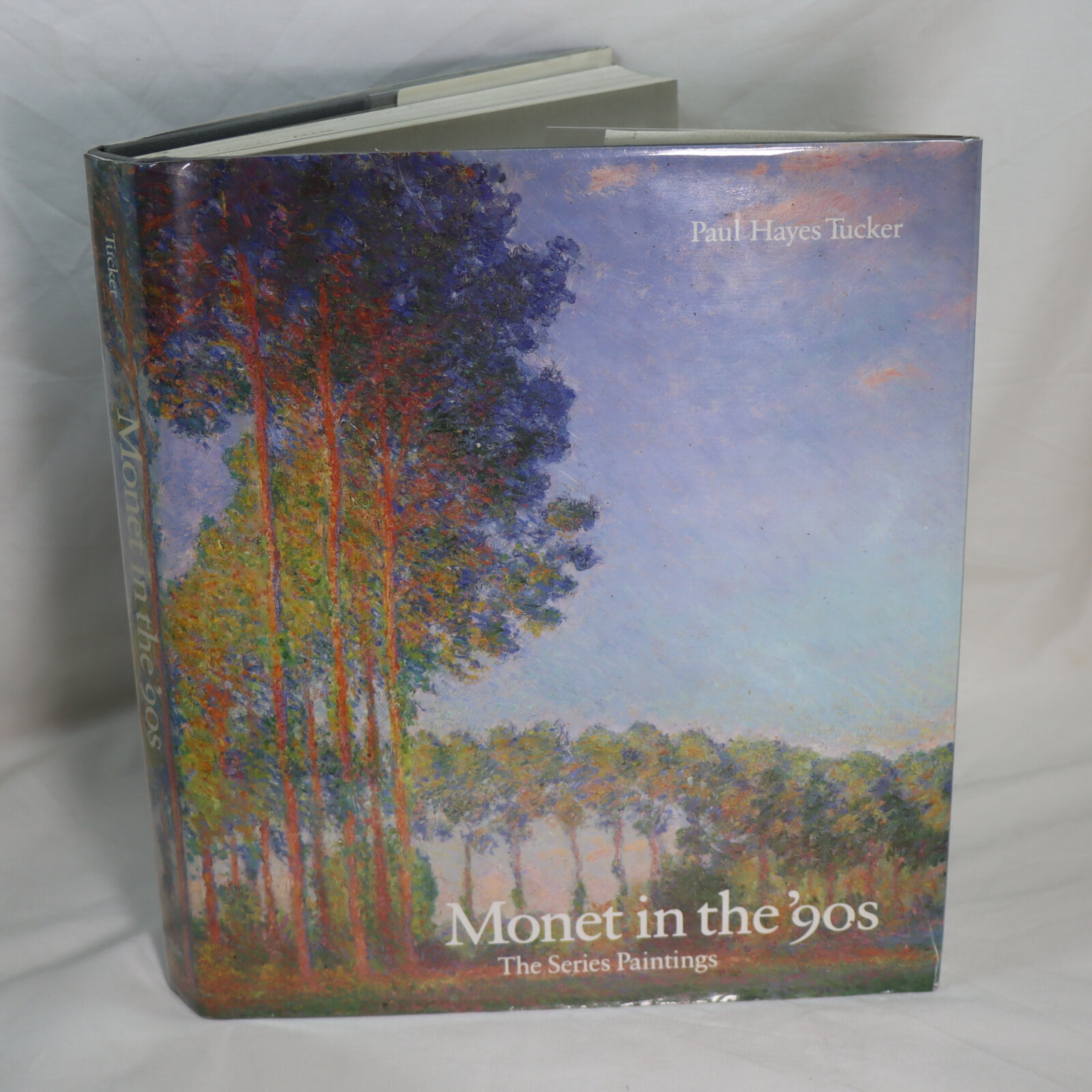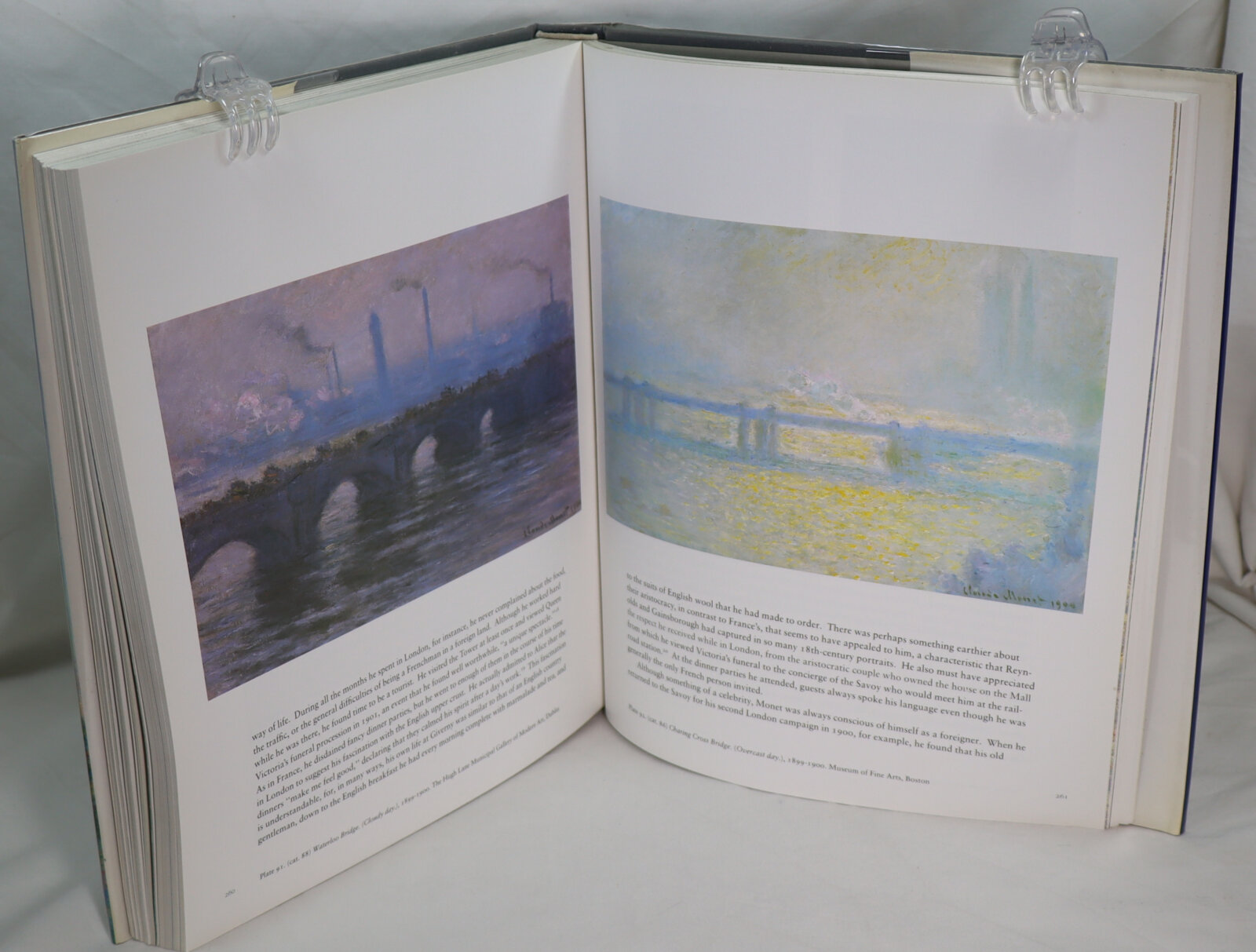Monet in the '90s.
By Paul Hayes Tucker
ISBN: 9780300049138
Printed: 1990
Publisher: Museum of fine Arts. Boston
| Dimensions | 25 × 29 × 4 cm |
|---|---|
| Language |
Language: English
Size (cminches): 25 x 29 x 4
Condition: Fine (See explanation of ratings)
Item information
Description
In the original dustsheet. Grey cloth binding with silver title on the spine.
-
F.B.A. provides an in-depth photographic presentation of this item to stimulate your feeling and touch. More traditional book descriptions are immediately available.
Monet’s famous series paintings?the haystacks, poplars, and Rouen Cathedral that he painted in the 1890s?have long been seen as the supreme realization of his interest in light, color and fleeting moments in time. In this beautiful new book, Paul Hayes Tucker provides a fresh context for these heralded canvases. Drawing on a wide array of sources, from popular broadsides to political speeches, Tucker proposes that Monet’s series paintings were not only an artistic response to the beauties of nature but were also related to contemporary events in France and to Monet’s determination to provide active leadership for his nation’s artistic production.
Monet, who had been accused earlier in his career of disregarding professional decorum and denigrating the aesthetic values that France held dear, was hailed by the end of the 1890s as one of the finest landscape painters of the century and as a great national artist. Tucker examines the circumstances that contributed to this shift in opinion: the changes in Monet’s art and in his life, an evolution in public taste, and the maturation of concerns the French had about their country and its place in the world. Tucker looks carefully at the development of Monet’s art before the 1890s, analyzing in particular the cultural pressures of the 1880s that caused Monet to turn to serial painting. He then focuses in considerable detail on the major and minor series from the ensuing decade, examining how they were painted, their critical reception, and the meaning they held for Monet and his public.
This engrossing study provides new subtlety to the series paintings, showing that their rich, encrusted surfaces, extraordinary light effects, and dazzling repetition of images touched deep aesthetic and nationalistic chords. In addition, as Tucker sets the paintings in this larger historical context, he also is able to give us a fresh perspective on Monet’s role in the continuities and contradictions of fin-de-siècle French culture. Publication of this book coincides with an exhibition of Monet’s series paintings of the 1890s. The exhibition opened in Boston in February 1990 and will move to Chicago in May and London in September.
Paul Hayes Tucker, associate professor of art at the University of Massachusetts in Boston, is also the author of Monet at Argenteuil.
Review: There are plenty of books on Monet, so to stand out from the crowd this has to be something special. It is. Though an exhibition catalogue, it is also a full-length study of Monet’s life and work, in the context of the artistic and political events in France, during the late 1880s and 1890s. Subtitled “The series paintings”, it collects together a substantial number of the works created while Monet was studying the atmospheric effects of light and colour by painting the same subject, from the same point, in differing conditions – most famously the haystacks, and the facade of Rouen cathedral. The illustrations are high quality and in many cases details are enlarged beside the illustration of the whole painting. Simply as a collection of reproductions it recommends itself to painters, students and fans alike. The text studies in detail Monet’s thoughts on his career and his concerns about his position in the artistic world of Paris at this time. All is set in the context of his forerunners and contemporaries, the philosophy of art as it stood at the time, and the opinions of critics. More than this, the author explains the importance of political events and in particular the cataclysm in public and social life precipitated by L’Affaire Dreyfus.
This is an impressive work of scholarship as well as a very enjoyable collection of some of the artist’s most evocative paintings. As well as the usual details of the works, and an index, there are notes and references, and an extensive bibliography. The chapter headings will give an idea of the ground covered:
– Monet and fin-de-siecle France.
– Monet and the Challenges to Impressionism in the 1880s.
– From the Massif Central to the Musee de Luxembourg; Monet in 1889
– Of hay and oats and stacks of grain; Monet’s paintings of agrarian France in 1890-91
– Rooted in “La France”: Monet’s popular paintings of 1891.
– From Rouen Cathedral to Mount Kalkas in Norway; religious and natural monuments 1892-95
– Normandy and the North; Monet’s cliff paintings of 1896 & 1897
– The changing of the light; Monet’s Mornings on the Seine of 1896-7
– Settling business in London
– Where East becomes West; Monet’s paintings of his Japanese bridge of 1899 and 1900.
Oscar-Claude Monet (14 November 1840 – 5 December 1926) was a French painter and founder of impressionist painting who is seen as a key precursor to modernism, especially in his attempts to paint nature as he perceived it. During his long career, he was the most consistent and prolific practitioner of impressionism’s philosophy of expressing one’s perceptions before nature, especially as applied to plein air (outdoor) landscape painting. The term “Impressionism” is derived from the title of his painting Impression, soleil levant, exhibited in 1874 (the “exhibition of rejects”) initiated by Monet and his associates as an alternative to the Salon.
Monet was raised in Le Havre, Normandy, and became interested in the outdoors and drawing from an early age. Although his mother, Louise-Justine Aubrée Monet, supported his ambitions to be a painter, his father, Claude-Adolphe, disapproved and wanted him to pursue a career in business. He was very close to his mother, but she died in January 1857 when he was sixteen years old, and he was sent to live with his childless, widowed but wealthy aunt, Marie-Jeanne Lecadre. He went on to study at the Académie Suisse, and under the academic history painter Charles Gleyre, where he was a classmate of Auguste Renoir. His early works include landscapes, seascapes, and portraits, but attracted little attention. A key early influence was Eugène Boudin who introduced him to the concept of plein air painting. From 1883, Monet lived in Giverny, also in northern France, where he purchased a house and property and began a vast landscaping project, including a water-lily pond.
Monet’s ambition to document the French countryside led to a method of painting the same scene many times so as to capture the changing of light and the passing of the seasons. Among the best-known examples are his series of haystacks (1890–1891), paintings of the Rouen Cathedral (1892-1894), and the paintings of water lilies in his garden in Giverny that occupied him continuously for the last 20 years of his life.
Frequently exhibited and successful during his lifetime, Monet’s fame and popularity soared in the second half of the 20th century when he became one of the world’s most famous painters and a source of inspiration for a burgeoning group of artists.
Want to know more about this item?

Related products
Share this Page with a friend












